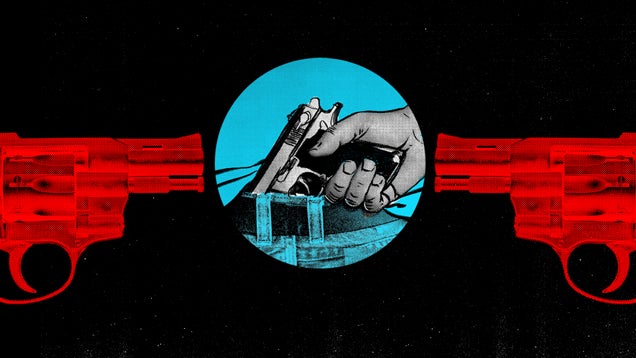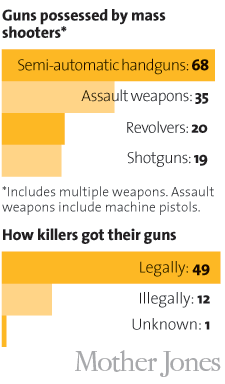- 32,642
- 11,805
- Joined
- Jul 11, 2006
Cliffnotes:[h1]It's Really Hard to Be a Good Guy With a Gun[/h1]
314,721
381
[h4]Adam Weinstein[/h4]Profile
Adam Weinstein

My wife and I got into an argument last night over a dead man. His name was Joseph Robert Wilcox. He was 31 on Sunday, the day he tried to stop cop-killer Jerad Miller in a Las Vegas Walmart and was shot by Miller's wife Amanda. Wilcox was a good guy with a gun. It cost him his life.
What I tried to explain to my wife—who thought Wilcox should have been running in the other direction, seeking cover—was that I could not blame him one bit. I could see myself doing exactly the same thing in the same scenario. Armed with a handgun and licensed to carry it concealed on his person, Wilcox read the situation, saw Miller—male, armed, firing a long gun and yelling—and thought he had an opportunity to end the threat.
He did not notice the diminutive woman on the sidelines with shopping cart and the handbag. She evidently had not made a scene. Wilcox approached Miller from behind. From his perspective, he had a chance to end the killing. From a broader perspective, he was already marked for death. Amanda came up behind him and pumped multiple shots into his ribs.
We had our biases in this argument. My wife is the child of a cop who's lost a partner in a shootout and had a lifetime of run-ins with wannabe civilian heroes. My father is one of those wannabe heroes. So am I. Dad and I have had our concealed carry permits for a combined 42 years. We love guns. We believe in self-reliance and self-protection.
But as the years go on and the country gets crazier—stirred up by paranoiacs, political hardliners, lobbyists, and simple gun-fetishists—I come nearer to my wife's side. The universe of scenarios in which carrying a gun seems prudent or useful just keeps shrinking and shrinking, even as the legal freedom to wield personal firepower keeps expanding. The NRA has recalibrated its message for the 21st century: "The only thing that stops a bad guy with a gun is a good guy with a gun." But in many ways, the 21st century has already overtaken us good guys.

I come from three generations of gunsmiths and armorers and collectors. By thirteen I had shot all manner of weapons, from a plinking .22 single-action Ruger revolver to an 1886 Winchester lever-action rifle with a cartridge the size of my middle finger—the buffalo gun, my father called it. In the military, I was an expert with rifles and pistols. I taught colleagues at Mother Jones, that venerable lefty mag, how to handle and fire an AR-15.
My NRA-member father raised me to believe principally in the right to own guns and the right to carry them responsibly, subject to the limits society and its laws place on us. When Florida started issuing concealed carry permits in 1987, Dad was among the first to sign up.
He runs a little boat-repair business out of a warehouse on the cheap side of Fort Lauderdale. For a time, his neighbors were drug dealers who produced amateur porn in their house. Robberies are common. He works late hours. Carrying a gun made sense—first, a little .22 derringer, then a 9mm Smith and Wesson, and finally a .45 Colt. When I turned 21 and applied for the license—it was fast-tracked when I showed the state my military expert-shooting records—I got the Smith police revolver, a .357.
In many ways I was not yet a grownup—still childish in love and in work, a renter and sometime student with not even a car title in my name. But with the license, and the gun, came a host of new grownup worries. First: Who do you shoot, and when?
Back when the licenses were still a new thing and the required instructional classes weren't a joke, my dad's class was run through a host of scenarios: You're broken down on a dirt road in the middle of the night. A black dude in a Cutty pulls up behind you, gets out, comes out with a tire-iron. What do you do? Half my dad's class said to shoot the black man.
That was not the answer the instructor sought. He put a premium on restraint, on knowledge that the lethal tool in your pocket or waistband was just that, a tool, and one with a limited range of uses. You don't bring a gun to a fistfight. You don't wave it or brandish it in a threatening manner, because guns rarely de-escalate a situation. And you don't shoot someone just because you're scared.
Over the years, even as I lived in a series of bad neighborhoods and sent the cops after a felon who threatened my family, my doubts about the usefulness of a firearm have compounded. What to carry? How to keep it concealed, but accessible? Keep it cocked and locked? Where would I leave it when going to a school campus, or a post office, or a courthouse?
And then there were the supposedly clear-cut scenarios, the ones every gun-lover thinks himself into: An armed perpetrator threatening your life. Do you shoot to stop, or shoot to kill? As I was taught, it was always the latter. Which meant my aim should be true. I was a typical gun person, in that I believed myself better trained than my peers, as good as a cop or a combat handgunner. But what proof did I have? And what risk was I willing to take?
There are too many scenarios. Say someone tries to mug me, and I'm armed, but they're already drawn down on me and I don't feel I have a safe shot. I'd be inclined to let them take what they want. But if they see my gun, I become the mortal threat, and perhaps they kill me preemptively. Should I preempt their preemption?
Say I shoot someone, and I'm fully within my rights to do it. How do I even present myself and my weapon to the cops in a way that doesn't alarm them and endanger me? How do I know the difference between an active shooter and a plainclothes police officer?
When my son was born, all of my questions suddenly had a very basic answer. I would love for him to grow up as I did, enjoying shooting but understanding that every gun is loaded and you never touch one without an adult and you don't point it at anything you don't intend to shoot. But more than that, I'd love to believe that he'll have no mischievous accidents, no suicidal depressions or homicidal rages, no moments of weakness or fits of pique or questions that can be answered by the pull of a trigger. As with all the other scenarios in which I'm the good guy with the gun, I can never be sure. I carry my permit, as I always have. But now all my guns live with my father.

At a time when the nature of our mass-shooting problem urges more circumspection, more responsibility on the part of gun owners, the law has barreled in the other direction: Concealed carry is easier than ever, in more places than ever; open carry is supplanting it in many states. My worries about carrying in courthouses and arenas seems quaint as states expand carry laws to cover virtually every space, even schools. (As a university instructor, I could only imagine the reaction from my students were I to strain to erase a note on a whiteboard and let a glimpse of my .357 pop up beneath my shirt.)
Florida's required concealed-carry course can now be taken in minutes at a gun show, revolving-door style. I doubt they even bother with that black-man-with-the-tire-iron scenario nowadays, since stand your ground has effectively taken away a gun owner's duty to retreat, to seek any way out of a nasty situation before turning it into a shootout. A recent expansion of the law even makes it legal to brandish your gun or pinch off a warning shot, which would have been unthinkable in the now-halcyon days of concealed carry's infancy.
The cultural effect of all these laws is to encourage a kind of hypervigilance that's simultaneously paranoid and arrogant. It encourages armed citizens to seek confrontations and escalate them, confident that they can end them definitively. That hypervigilance looks at my questions and scenarios and doubts and says, like a drill instructor in a true army of one: "Then don't carry a gun, you equivocating *****. Leave the defending to us real men."
Fine. I leave it to you, the hypervigilant. Even though the statistics show mass shootings are on the rise, and not one has been stopped by armed good guys—armed civilian good guys. In fact, they've been shot more often than they've shot the baddies. Which is natural, since assault weapons are on the rise, and it's hard to conceal a weapon that can outshoot someone with a Bushmaster. I leave it to you, because I still puzzle in my mind over all the tactical difficulties posed by someone in civilian clothes carrying a gun during a shooting. (How do you telegraph your goodness to the cops and bystanders?)
I'd like to support you in your supreme confidence. I'd like to stand up for your right and trust that you take care in the responsibilities that come with it. But I can't be certain of that, any more than I can be certain that my aim is true, or that in the heat of the moment, another Amanda Miller isn't waiting for you or me.
- Man tried to stop the Las Vegas Walmart shooting last week with a gun he was legally permitted to carry. He ended up being shot dead.
- Not one mass shooting yet has been stopped by an armed civilian, or good guy.
- In fact in recent years 2 armed civilians trying to stop mass shooters have been killed
- Concealed carry permits and a firearm can be had in a matter of minutes following a short test taken at a gun show
Last edited:








 guns...
guns...